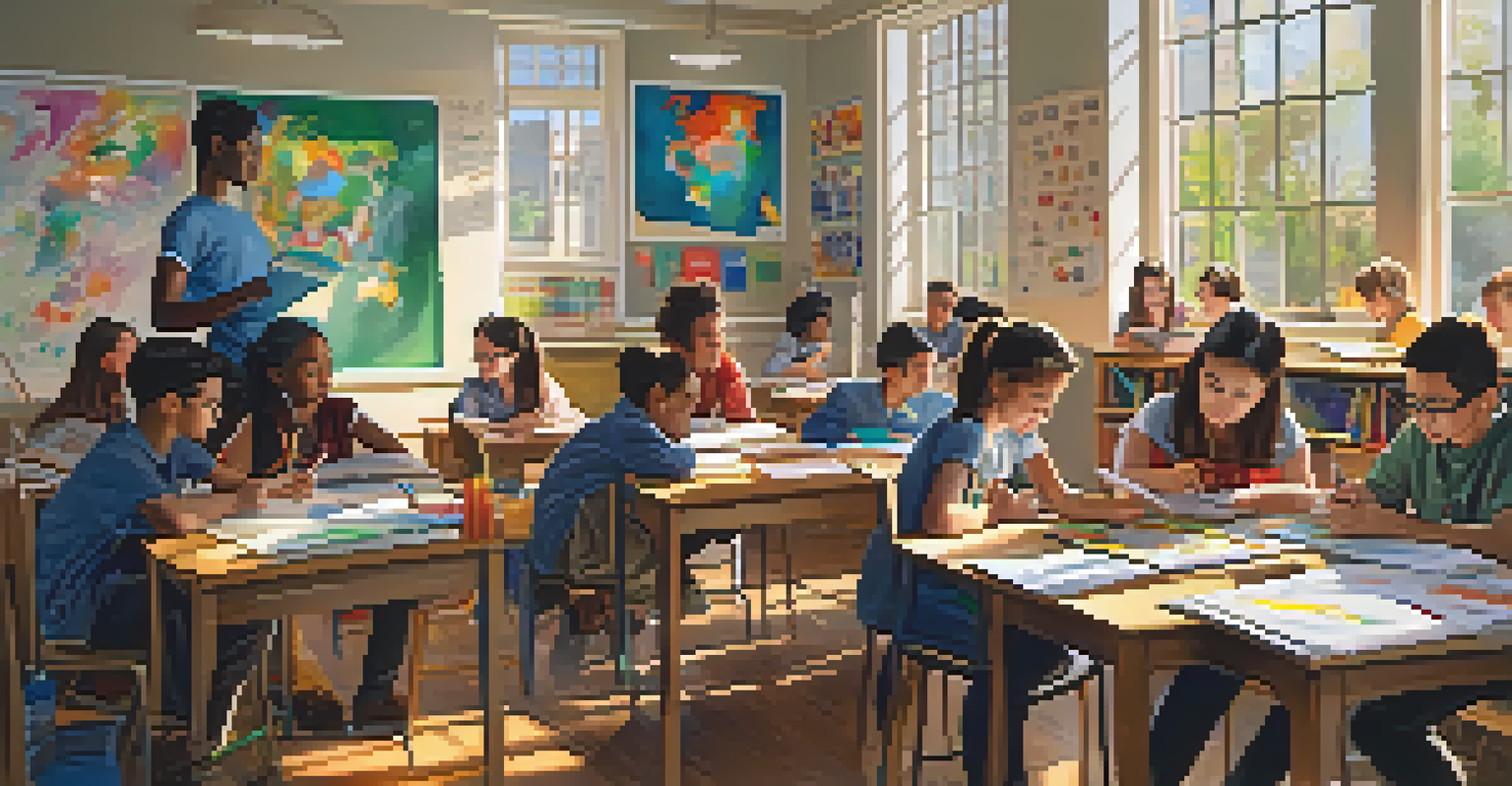How Spirituality Enhances Teacher-Student Relationships

Understanding Spirituality in Education
Spirituality in education often refers to fostering a sense of connectedness and meaning in the classroom. It doesn't necessarily imply religious beliefs but instead emphasizes values like compassion, empathy, and mindfulness. When teachers integrate these principles, they create a nurturing environment conducive to learning.
Education is not the filling of a pail, but the lighting of a fire.
This approach encourages teachers and students to explore deeper questions about life, purpose, and individual growth. Such exploration can lead to a more holistic educational experience where emotional and spiritual well-being is prioritized alongside academic achievement. In short, spirituality enriches the educational landscape by focusing on the whole person.
By recognizing each student's unique spiritual journey, educators can foster a greater sense of belonging and respect. This understanding allows for more personalized interactions, ultimately enhancing the teacher-student relationship. As a result, students feel more valued and understood, which can significantly impact their academic journey.
The Role of Empathy in Teacher-Student Relationships
Empathy is a cornerstone of spirituality and plays a crucial role in nurturing teacher-student relationships. When teachers approach their students with empathy, they create a safe space for open communication and emotional expression. This connection helps students feel seen and heard, which can significantly enhance their learning experience.

For example, a teacher who listens actively to a student's concerns demonstrates that they care about more than just academic performance. This kind of attention fosters trust, allowing students to engage more fully in their education. As trust builds, students are more likely to seek help and share their challenges, leading to improved outcomes.
Spirituality Enriches Learning
Integrating spirituality in education fosters a nurturing environment that prioritizes emotional and spiritual well-being alongside academic achievement.
Moreover, empathetic teachers can model emotional intelligence, teaching students the importance of understanding and managing their own feelings. This skill not only enhances their relationships with peers but also prepares them for future interactions beyond the classroom. Ultimately, empathy nurtured through spirituality strengthens bonds and enriches the learning environment.
Creating a Mindful Classroom Atmosphere
Mindfulness is an essential aspect of spirituality that can transform classroom dynamics. When teachers practice mindfulness, they become more present and engaged with their students. This focus allows them to respond to students' needs more effectively, fostering a supportive learning environment.
The greatest gift you can give to others is the gift of unconditional love and acceptance.
Incorporating mindfulness practices, such as meditation or breathing exercises, can also benefit students. These techniques help reduce anxiety and improve concentration, allowing students to be more engaged in their learning. As students learn to ground themselves, they become more aware of their emotions and the feelings of others, enhancing their interpersonal relationships.
Furthermore, a mindful classroom encourages open dialogue about feelings and experiences. This openness allows students to share their thoughts without fear of judgment, helping to create a sense of community. In this environment, both teachers and students can grow together, deepening their connections.
Fostering a Sense of Community
Spirituality can cultivate a strong sense of community within the classroom, making students feel connected to one another. When teachers emphasize shared values and collective goals, it encourages collaboration and teamwork among students. This bond can lead to lasting friendships and a supportive learning environment.
For instance, group activities that promote cooperation and understanding can enhance this sense of community. By working together towards a common objective, students learn to appreciate diverse perspectives and backgrounds. This appreciation fosters respect and compassion, key components of a spiritually enriched classroom.
Empathy Strengthens Connections
Empathetic teacher-student relationships create a safe space for open communication, enhancing students' learning experiences and emotional growth.
As students build relationships with one another, the teacher's role evolves into that of a facilitator who guides these connections. This shift allows teachers to focus on the group's dynamics, helping students to develop crucial social skills. Ultimately, a strong sense of community enhances the overall educational experience for everyone involved.
Encouraging Personal Growth and Self-Discovery
Spirituality encourages personal growth and self-discovery, which are vital for both teachers and students. When educators embrace their spiritual journeys, they model the importance of continual learning and self-reflection. This example inspires students to explore their own identities and beliefs.
Teachers can create opportunities for self-discovery by incorporating reflective practices into the curriculum. Activities like journaling, discussions on values, or exploring personal interests can help students connect with their inner selves. This connection not only enhances their self-awareness but also boosts their confidence.
As students grow personally, they are more likely to engage positively with their peers and teachers. This growth fosters deeper relationships as students share their experiences and insights, creating a more profound understanding between everyone involved. In this way, spirituality nurtures both intimate connections and individual development.
Embracing Diversity in Spiritual Perspectives
Incorporating spirituality in education also means embracing diverse spiritual perspectives among students. Every student comes with their own beliefs and values, and recognizing this diversity enriches the classroom experience. When teachers respect and celebrate these differences, it fosters an inclusive environment.
For example, encouraging students to share their spiritual or cultural practices can create a rich tapestry of experiences. This exchange not only broadens everyone's understanding but also promotes respect and empathy. Students learn that spirituality can take many forms, leading to greater acceptance and appreciation of one another.
Diversity Enhances Classroom Dynamics
Embracing diverse spiritual perspectives in the classroom cultivates respect and understanding, enriching the educational experience for all students.
By integrating diverse perspectives into discussions and activities, teachers can create a dialogue that respects all beliefs. This approach nurtures critical thinking and encourages students to question their assumptions. Ultimately, embracing diversity strengthens the teacher-student relationship and creates a more harmonious classroom.
The Lasting Impact of Spirituality in Education
The integration of spirituality into education has lasting impacts on teacher-student relationships. When educators prioritize spiritual values, they create a foundation of trust and respect that can last well beyond the classroom. These relationships often extend into students' lives, influencing their personal and professional development.
As students carry these lessons into adulthood, they are more likely to approach their relationships with empathy and understanding. The values instilled through spiritual education can shape their interactions, fostering a more compassionate society. This ripple effect demonstrates the profound influence teachers can have on their students' lives.

In conclusion, the embrace of spirituality in education not only enhances relationships but also cultivates a generation of mindful, empathetic individuals. By nurturing these connections, we contribute to a more harmonious and understanding world, one student at a time. The journey of spiritual growth in education is truly transformative for all involved.